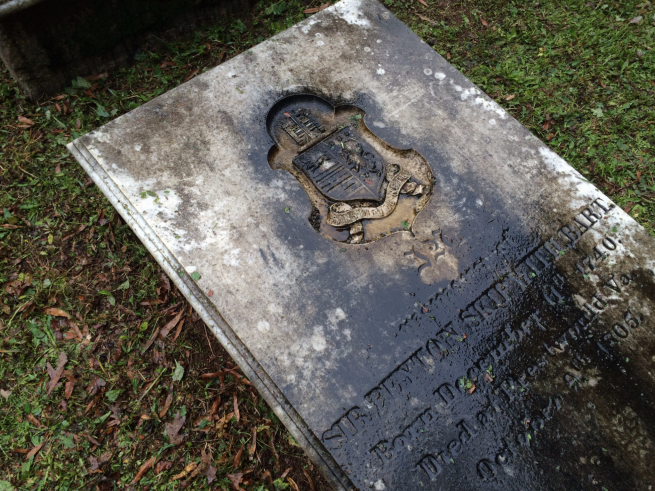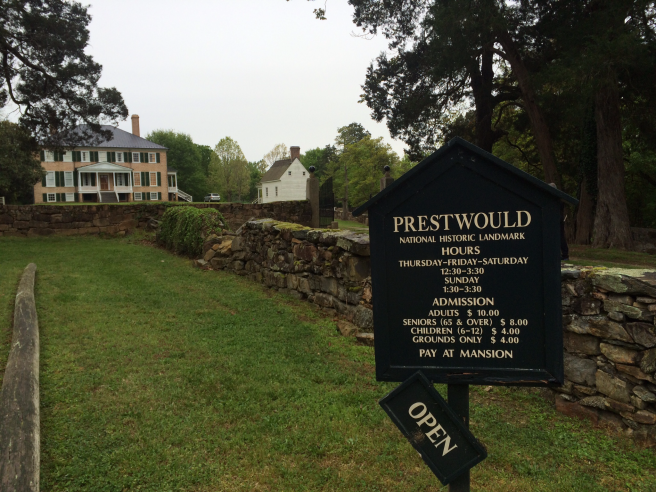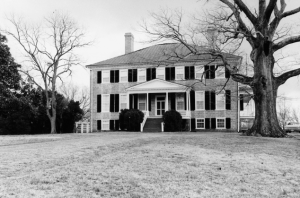
This edifice and its appendages stand on a very commanding height half a mile from the Roanoke which is formed opposite the door by a junction of the Dan and the Staunton . . . . The ground to the river is sloping, wavy and highly improved to a great extent up and down, which affords a fine view of the rivers and of an Island between the two latter of upwards of 1,000 acres in which that of cultivation — upon the whole — except New York or up the North River I have never seen anything so handsome.
— Letter from Wade Hampton to Aaron Burr, 25 October 1800.
Prestwould was home to four generations of the Skipwith family. The builders were Lady Jean Skipwith (1748-1826) and her husband Sir Peyton Skipwith (1740-1805). The second generation to occupy the plantation, Humbertson Skipwith (1791-1863) and his wife Lelia made modest changes to the plantation in the 1830s, but significantly upgraded the decor with the addition of grain-painted doors and very fashionable French scenic wallpapers by Jacquemart and Zuber.
As noted in the National Historic Landmark application for the property, “The domestic core of Prestwould was one of the most substantial home plantation complexes constructed in post-Revolutionary Virginia, and it survives remarkably intact.” The surviving buildings include the main house, summerhouse, office, loom house, store, smoke houses and slave houses. All of the dependencies are down slope of the main house. The arrangement of the buildings evoke life of the planter gentry in the early 19th century, and they are a significant and unique survivors.

The exterior is a rectangular, two-story structure with a hipped roof, built of cream-colored sandstone. Completed in 1795, the house stands in the center of the plantation complex. Relatively plain, the house has gable roof porches on the principal façade that faces the road, and the matched rear façade that faces the river. Having two fronts is an idiom common in the Chesapeake, where travel by the numerous rivers was more common than travel over land.
The interior of the house is especially noteworthy. The National Landmark Application describes it this way:
Outwardly conventional, Prestwould’s interior is remarkable for its juxtaposition of woodwork that reflects conservative architectural tastes with a circulation pattern so sophisticated as that of any large late eighteenth-century house in America. What architectural historians Edward Chappell and Willie Graham of Colonial Williamsburg Foundation have called the “marked division between rooms used for entertainment, family life and service” can be viewed as the culmination of a process that began in the Chesapeake a century earlier (Edward Chappell and Willie Graham, “Prestwould Architecture,” The Magazine Antiques, 147 (1995), 158). Evidence for the preference wealthy Virginians expressed for the careful delineation of public from private rooms survives in the names Sir Peyton Skipwith gave rooms in his new house. Prestwould’s plan, by means of service stairs, service entrances, and service closets that doubled as service passages, imposed these attitudes on the household, segregating service functions from both public and private rooms and the activities they contained. Prestwould’s floor plan also created a circulation pattern that rigorously channeled interaction between the family and the enslaved Africans who provided all household services. Prestwould’s plan, in other words, provides good evidence, first, of the evolution and increased sophistication of interior circulation patterns within the houses built by Virginia’s wealthy eighteenth-century planters, and second, the growing segregation of room function that was both a reflection of the pursuit of architectural refinement in late eighteenth-century Virginia and evidence of on-going adjustments to an enslaved labor force.
With its high degree of architectural integrity and remarkable preservation, its a pity that Prestwould is not so well known as other historic houses. Its preservation is no doubt aided by its location in rural Southern Virginia, which even today is not that well traveled. Given that it has not been altered, architectural historians from Colonial Williamsburg turn to Prestwould for information about eighteenth-century buildings, construction methods, and household furnishings and fixtures. The building and family are well documented, for the Skipwith family papers are preserved at Swem Library in Williamsburg, the Virginia Historical Society in Richmond, and the University of Virginia in Charlottesville.
Getting there:
Prestwould is about 30 minutes south of Annefield, located two miles north of Clarksville on US Route 15. Open April 15 to October 31, Tuesday through Saturday, 12:30 pm — last tour at 3 pm; Sunday, 1:30 pm — last tour at 3 pm. Gates close at 4 pm. 429 Prestwould Drive, Clarksville, Virginia 23927 (434) 374.8672. Photography indoors is prohibited.
















